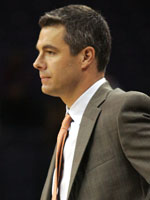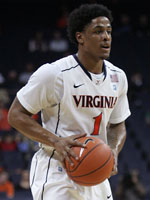 |
|
Coach Tony Bennett and the Hoos hope to open ACC play with a win vs. Miami. |
The Virginia men’s basketball team soared to a 13-1 record during non-conference play, including what has grown to an 11-game winning streak. The Cavaliers hope to keep grabbing victories when ACC play begins Saturday night at the John Paul Jones Arena. First up on the conference schedule is Miami, a team coached by former UVa assistant coach Jim Larranaga.
Here’s a primer on the Hurricanes.
1. Miami is ranked No. 67 in KenPom, No. 86 in TAPE, and No. 75 in RPI. So far, the Hurricanes have beaten all of the opponents that they were supposed to beat and lost to all of the better teams they’ve played (at Ole Miss by 3, at Purdue by 11, Memphis by 17, and at West Virginia by 11). That said, you can take these rankings and all of these losses and toss them in the trash … and then douse them with gasoline and set them ablaze.
Why? They’re meaningless. They came when the Hurricanes were paper thin in the frontcourt with only one player taller than 6’6″. Then, four games ago, the Canes welcomed back big man Reggie Johnson from offseason knee surgery. Three games ago, senior swingman DeQuan Jones was cleared to play by the NCAA after being deemed ineligible. Now Miami has won its last four games, albeit none against great competition (FAU in OT, at Charlotte, Appalachian State, UNC Greensboro) and has looked like a completely different, if not necessarily better, team. Keep in mind, though, that leading scorer Malcolm Grant missed the middle two games in this four-game stretch because of a loss in his family, meaning that Miami’s last game against UNC Greensboro was the first game in which the Canes have been at full strength, with Johnson, Jones, and Grant all playing in the same game. That said, the result, a 99-89 win over a terrible Greensboro team, shows that the team still has a long way to go.
2. Part of that process is the result of the arrival of new coach Jim Larranaga, who had tremendous success at George Mason after more moderate success at Bowling Green (and an assistant gig to Terry Holland at UVa). Larranaga replaced Frank Haith, who is now at Missouri, and their coach is not the only thing that the Hurricanes lost from the team that ripped Virginia’s hearts out down in Coral Gables and then again at the ACC Tournament last season. Adrian Thomas, who killed the Hoos in Coral Gables, going for 20 points and 10 rebounds (and making 6 of 12 shot from long range), has graduated. And Julian Gamble, who went for 11 points and 5 rebounds (on 5-of-6 shooting) against UVa in the ACC Tournament, is out for the year with a torn ACL.
3. On defense, Larranaga’s teams run his famous scramble defense, a pressure man-to-man defense with trapping principles. That said, early in the season, “over easy” was a more accurate description of the Canes’ D. They rank No. 137 in adjusted defensive efficiency and No. 235 in turnovers forced. But again, these numbers mean nothing. When you don’t have the frontcourt players to back up gambling guards, and when you don’t have the depth to turn up the pressure, your defense is going to suffer. With the Hurricanes back at full strength, Larranaga has said that you can expect a more attacking defense, and that’s exactly what happened against UNC Greensboro as Miami forced 20 turnovers and jacked up the pace, with 83.8 possessions in the game (compared to a season average of 69.2).
But here’s the thing: Miami is still (understandably) learning the scramble, and while it forced a lot of turnovers and a harried pace against Greensboro, it also gave up a lot of open shots (the game may still be archived on ESPN3 for anyone interested). Greensboro shot lights out from 3-point range (52.4%) with many of the looks being uncontested and a solid 48.5% overall from the field, with many of the 2-point shots being layups and dunks. I think that Miami will be great at defense next year and pretty good in the back nine of ACC play, but they Hurricanes are not (close to) there yet. If Virginia is careful with the ball (and that’s a big IF at times against pressing teams), it should get some good quality shots if it can push the ball past the first line of pressure.
 |
|
UVa must deal with pressure defense and good shooters in this matchup. |
4. On offense, Larranaga’s teams mostly run three different zone offenses, the slice and dice zone, the seek and find zone, and the crack and carve zone. You can do a Google search for the intricacies of these offenses, but the main aspect of the former two is that they are 4-out offenses, starting with only one player in the post and four players outside of the 3-point arc, with a good variety of screens to set up penetration and open 3-pointers. I mostly saw Miami use the former two offenses against Greensboro, but that might have been because Reggie Johnson played only 15 minutes because of foul trouble. UVa has had mixed success against 4-out offenses on the year, shutting down Michigan but often getting abused by the bigger bodies of Seattle.
5. That leads me to the two statistics I always check for opposing teams: offensive rebounding and turnovers forced. Teams that fare well in these two categories tend to play well against Virginia, and that was certainly the case in the two losses against the Hurricanes last year. They forced 10 turnovers and nabbed 8 offensive rebounds (and beat the Hoos 41-29 on the boards) in Coral Gables, and the relevant numbers were 13 and 9 in Greensboro. This year, Miami is No. 250 in offensive rebounding and No. 233 in turnovers forced, but again, those numbers are worthless given that the Canes are just now getting back to full strength. With the scramble defense and some bigs back, Miami has the potential to be good in both categories.
6. Starting lineup …
At point guard, 6’5″, 202-pound junior guard Durand Scott mans the helm for the Canes, and he’s not a true point guard. Picture Malcolm Brogdon running the point for the Hoos in a couple of years and you have a pretty good picture of Scott. His handle is a bit loose, but his assist-to-turnover ratio of 3.5-1.8 is actually pretty good. He’s a plus rebounder at the PG spot at 4.5 per game and a good scorer (13.3 PPG) but not great shooter (40.6% from the field, 31% from long range). Last year, UVa pretty much kept him in check as he shot 7-22 with 2 assists and 4 turnovers in the two games combined; I expect Jontel Evans and Brogdon to keep him clamped down this year as well.
At shooting guard for Miami is 6’1″, 188-pound senior Malcolm Grant, who leads the Canes in scoring at 14.5 points per game and never met a shot he didn’t like (he leads the team with 12.2 attempts per game). The majority of those shots come from long range (7.2 vs. 5), which makes sense given that he’s 36.7% from outside the arc and 40% from inside it. Like many mad bombers, he doesn’t really bring the intensity on the defensive end, so Sammy Zeglinski could find himself with some open 3-point opportunities. Last year, Grant did pretty much what you would expect against Virginia, scoring a lot (27 points in the 2 games), but not doing so very efficiently (7-of-25 shooting).
At the “3” or small forward spot for Miami is 6’5″, 216-pound redshirt junior Trey McKinney Jones. Jones is a very athletic and rock solid player for the Canes. Statistically, he posts 8.5 PPG, 4.5 RPG, 48.2% shooting from the field, 35.4% shooting from 3, and 85.7% shooting from the free throw line. He was redshirting last year, so this is the Cavaliers’ first look at him, and he could cause Joe Harris some trouble on both ends although I think that we have the advantage here.
At the power forward position is Kenny Kadji, a 6’11”, 251-pound redshirt junior from Cameroon by way of the University of Florida, who kept the center position warm while Reggie Johnson was rehabbing. He was slow out of the blocks but has picked his game up of late, culminating with his 30-point, 12-rebound performance against Greensboro. He’s averaging about 10 points and 5 rebounds on the season and is efficient from the floor (54.3% shooting) but not from
the line (59.6%). I don’t know that he has the defensive game to slow Mike Scott down.
At the center slot for Miami is Reggie Johnson , a junior listed at 6’10”, 284 pounds. He’s recently back from knee surgery, and he put on some (bad) weight in his time off. I would guess that he’s currently pushing 300 pounds. In his four games back, he’s averaging 10.8 points and 6.5 rebounds and has seemed to keep most of his agility despite the weight gain. That said, the teams that Miami has played haven’t forced him to work that hard. Assane Sene should change that if he can play like he did against him in Greensboro last year, when he limited the big guy to 8 points and 6 rebounds.
Key reserves include …
Point guard Shane Larkin is a 5’11”, 160-pound freshman with a better handle than
Scott, and I really like his game. He’s averaging 8.8 points and 2.4 assists in 25.3 minutes per game; he is a great shooter from 3 (43.6%). That said, while he’s good at driving and dishing, he can be a bit reckless with the rock as evidenced by his 2.1 turnovers per game. I’m not sure how much a frosh of his size will be able to penetrate against the Pack Line defense, but he can be a disruptive force defensively (he leads the Canes with 1.8 steals/game).
Forward DeQuan Jones is a 6’7″, 221-pound senior, who, as noted, is recently back after reinstatement by the NCAA. In three games, he’s averaging 7 points and 5.3 rebounds in 15.7 minutes. Jones is very athletic and a good defender, but he’s not that polished on offense and had difficulty scoring against the Hoos last year (2 points on 1-of-5 shooting in Greensboro).
Forward Rion Brown is a 6’6″, 194-pound sophomore that averages 6.4 points in
17.2 minutes per game. He is another straight shooter from long range (46.7%). Last year, he was very efficient against UVa, nabbing 17 points in the two games on 5-of-9 shooting, including 4 of 6 from long range.
7. 504-C Brandon, another Sabre poster, predicts a 63.2-53.1 UVa win on his blog, with the Hoos having
an 82% shot of winning. The Team Rankings simulation (click here) has it as a 64.1-60.8 UVA. Again, though, these predictions are both based upon season stats, which are unreliable given Miami’s new personnel. With Miami at full strength, I expect the pace to be a bit faster than expected although UVa will certainly try to slow things down. Against Greensboro, Miami scored many of its points off of fast breaks and quick outlet passes from rebounds. I’m sure coach Tony Bennett wants to see how often the Hurricanes can score out of halfcourt sets.
In conclusion, I’m going to predict a 67-61 win for UVa but I’m sure that few of us Cavalier fans will
feel safe until the clock strikes double zeros given what happened last year.
Author’s Note: Many of the statistics and analysis in this article were gathered through watching the two Miami/UVa games last season, watching the Miami-UNC Greensboro game this season, ESPN.com, 504-C Brandon’s TAPE site, Warren Nolan RPI site, Miami’s Scout site, The Orlando Sentinel, and KenPom.com.



